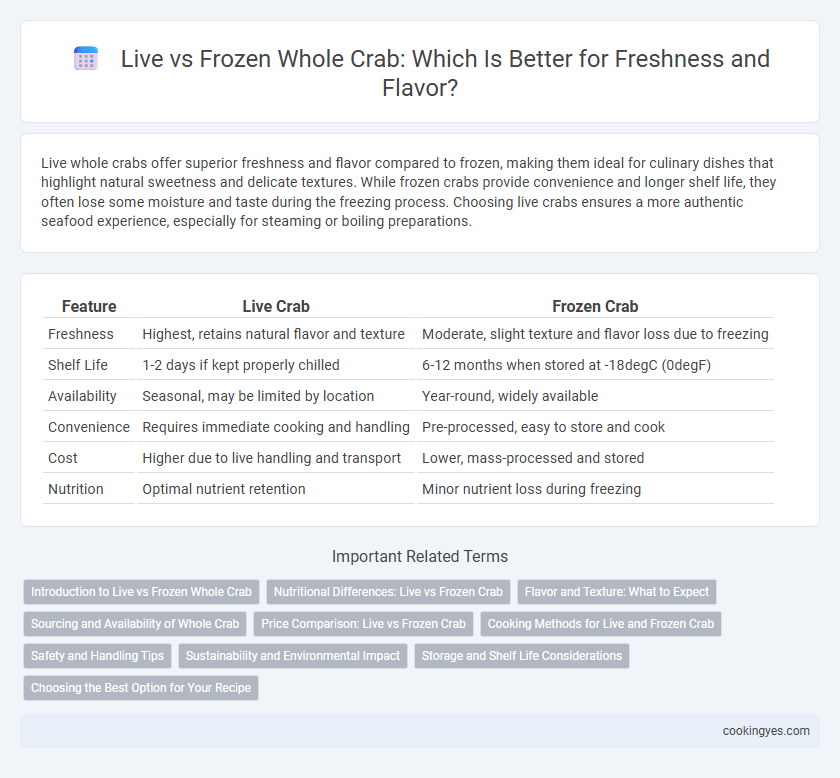Live whole crabs offer superior freshness and flavor compared to frozen, making them ideal for culinary dishes that highlight natural sweetness and delicate textures. While frozen crabs provide convenience and longer shelf life, they often lose some moisture and taste during the freezing process. Choosing live crabs ensures a more authentic seafood experience, especially for steaming or boiling preparations.
Table of Comparison
| Feature | Live Crab | Frozen Crab |
|---|---|---|
| Freshness | Highest, retains natural flavor and texture | Moderate, slight texture and flavor loss due to freezing |
| Shelf Life | 1-2 days if kept properly chilled | 6-12 months when stored at -18degC (0degF) |
| Availability | Seasonal, may be limited by location | Year-round, widely available |
| Convenience | Requires immediate cooking and handling | Pre-processed, easy to store and cook |
| Cost | Higher due to live handling and transport | Lower, mass-processed and stored |
| Nutrition | Optimal nutrient retention | Minor nutrient loss during freezing |
Introduction to Live vs Frozen Whole Crab
Live whole crabs offer superior flavor and texture due to their freshness, making them ideal for culinary dishes that require delicate, sweet meat. Frozen whole crabs provide convenience and extended shelf life, maintaining quality through flash freezing that preserves nutrients and taste. Choosing between live and frozen crabs depends on availability, preparation time, and desired freshness for the recipe.
Nutritional Differences: Live vs Frozen Crab
Live crab retains higher levels of essential nutrients such as omega-3 fatty acids, vitamins B12 and D, compared to frozen crab, which may experience nutrient degradation during freezing and storage. The freezing process can reduce the bioavailability of certain antioxidants and cause slight protein denaturation, impacting overall nutritional quality. Optimal freezing methods and quick freezing times help preserve nutrient content but generally cannot fully match the freshness and nutrient density found in live crab.
Flavor and Texture: What to Expect
Live whole crab offers superior flavor and texture, boasting sweet, succulent meat with a firm, tender bite that is prized by seafood connoisseurs. Frozen whole crab can lose some of its natural sweetness and develop a slightly mushy or waterlogged texture due to ice crystal formation during freezing. When freshness is paramount, live crab ensures the best culinary experience, while frozen crab provides convenience with a modest compromise in flavor and texture quality.
Sourcing and Availability of Whole Crab
Live whole crabs are sourced directly from coastal fisheries and specialized seafood markets, ensuring superior freshness but with limited availability due to seasonal fishing regulations and regional constraints. Frozen whole crabs, harvested at peak freshness and flash-frozen shortly after capture, offer year-round availability and broader sourcing from international suppliers, maintaining quality while overcoming geographic limitations. Buyers often choose frozen options to secure consistent supply and access to diverse crab species beyond local fishing seasons.
Price Comparison: Live vs Frozen Crab
Live crabs typically command higher prices due to their freshness, perceived quality, and the logistical costs of maintaining their vitality during transport. Frozen crabs, while generally more affordable, offer convenience and longer shelf life, making them a cost-effective option for consumers and retailers. Market trends indicate that seasonal supply and regional availability significantly influence price fluctuations between live and frozen whole crabs.
Cooking Methods for Live and Frozen Crab
Live crabs require boiling or steaming immediately to preserve freshness and texture, with cooking times typically ranging from 15 to 20 minutes depending on size. Frozen crabs should be fully thawed before cooking to ensure even heat distribution, and are best prepared by roasting or steaming to retain flavor and moisture. Both live and frozen crabs benefit from seasoning with garlic, lemon, or Old Bay for enhanced taste during cooking.
Safety and Handling Tips
Live crabs, when handled properly, ensure freshness but require careful storage at temperatures just above freezing to prevent bacterial growth and stress. Frozen whole crabs must be kept consistently below 0degF (-18degC) to maintain safety and quality, avoiding thawing and refreezing cycles that increase contamination risks. Consumers should always thaw frozen crab slowly in the refrigerator and cook promptly to minimize foodborne illness hazards.
Sustainability and Environmental Impact
Live whole crabs have a lower environmental impact compared to frozen ones, as they avoid the energy-intensive freezing process and reduce food waste by ensuring freshness. Sourcing live crabs from local, sustainable fisheries supports marine ecosystems and maintains crab populations. Frozen crabs, often transported long distances, contribute to higher carbon emissions and may have less transparent supply chains impacting sustainability.
Storage and Shelf Life Considerations
Live crabs require immediate storage in cool, moist environments with temperatures between 32degF and 45degF to maintain freshness and extend shelf life up to 2 days. Frozen whole crabs, stored at 0degF or below, can retain quality for up to 6 months, making them a more convenient option for long-term storage. Proper packaging and consistent freezing temperatures are critical to prevent freezer burn and preserve the crab's texture and flavor.
Choosing the Best Option for Your Recipe
Selecting between live and frozen whole crab depends on recipe requirements and desired flavor profile. Live crab offers fresher taste and firmer texture, ideal for dishes needing delicate extraction of natural sweetness. Frozen crab provides convenience and longer shelf life, perfect for recipes where crab is cooked in sauces or mixed dishes, maintaining quality with proper thawing.
Live vs Frozen for whole crab Infographic

 cookingyes.com
cookingyes.com